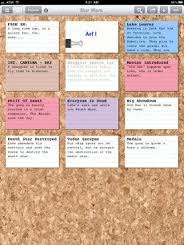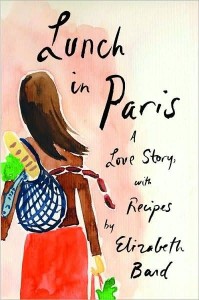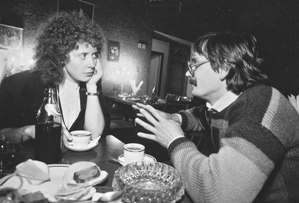Stories To Tell Books BLOG
Filtering by Category: Getting Started on Your Book
Why You Should Keep a Writer's Journal
Biff Barnes
The Value of a Journal
Biff Barnes
Tried and True Organization for Your Family History?
Nan Barnes
What’s the best way to organize a big project, like a family history book?
We regularly teach a seminar, How to Plan and Organize a Family History Book. We recommend that people begin with the big ideas first, listing what should go into the book. And ultimately, they should arrive at an outline. But in the middle between these two points, there’s a murky area, a process that seems to stump our audiences.
Ironically, the sticking point comes when we refer to a process we all probably learned in middle school: index cards. Remember them? There are software variations now, using the same principles of organization.

We like index cards because they are hands on, they’re visual, and they are easy to change, add or discard. You can use different colored cards to designate big ideas, subheadings and specific details. After you develop one organization, it’s easy to move the cards to a different arrangement of ideas. When you’re happy with the way the cards are arranged, you can transfer the ideas on the index cards to paper and you’ve got a preliminary outline.
For most folks the index card method makes perfect sense, but others just don’t get it. “Should it be a red card or a green card?” they ask. “How many subheadings should I have under a big idea?” The very strength of the system, its flexibility, confuses people.
Do you have other techniques to suggest? How do you like to organize ideas for a big project? Post a comment and share with us, and our readers, your favorite method of organizing. We’ll look forward to reading what you have to say and I’m sure our readers will too.
Begin Your Family History Book With the End in Mind
Biff Barnes
Stephen Covey offered some sound advice when he said that highly effective people “begin with the end in mind.” That’s certainly true for family historians setting out to create a book. It would be difficult to ever get your family history into print if you didn’t have a pretty clear idea of what it will look like when it’s printed.
In some of our workshops Nancy and I use a simple exercise to help authors at the beginning of the process of creating a book visualize the finished product. It’s designed to help focus on the book’s intended audience. We ask the workshop participants to create a dedication page for their book by answering two questions:
- Who is this book for?
- Why are they special to you?
Having decided upon whom you will be writing for, you can decide what will make your book special for that person.

Many people we meet want to write a book for their grandchildren. A book for younger readers should focus on a lively account of ancestors using stories and anecdotes to pique the kids’ interest. You should also understand that younger readers growing up in a digital world are often much more visually oriented than their elders so effective use of photos and other illustrations will be an important way to draw them into the book.
On the other hand, a person whose goal is to create a serious document for future family historians and genealogical researchers will want to emphasize facts, documentation and sourcing. Charts and graphic may be very effective in organizing the factual details of the book. Extensive footnotes or endnotes on sources and documentation will play a more important role in your book.
Your initial visualization of the type of book you want to create will help you decide the best way to organize your family history research and make choices about what to include and what might better be left out. It can also help you decide how you might deal with more than one goal while focusing on you target audience. If you are writing primarily for the grandchildren you can still attend to source notes and documentation in an appendix or even in a CD placed in a sleeve on the inside back cover. The kids may never look at it, but future researchers will thank you.
Some early thought to the exact type of book you want to produce will save you a lot of time during the creative process and will help you produce a much better book in the end.
New Books for Memoirists, Family Historians and Self Publishers
Biff Barnes
My bookshelf is stacking up. I have three books that I want to get to in the next few days. You may hear more about them when I do.
The first to arrive is Mark Levine’s The Fine Print of Self Publishing. Levine is the President of Published.com a division of the Hillcrest Publishing Group, Inc. He has researched self publishing options offered by 45 companies. The book’s goal is to help writers choose ethical self-publishing companies and avoid book publishing companies that are nothing more than dream-crushing scam artists.

Tim Bete, Director, Erma Bombeck Writers' Workshop said of Levine’s book, "It would take years for an author to compile all the research that Mark Levine has and, even then, most authors wouldn't be able to analyze the self-publishing companies and their contracts the way Levine does. The Fine Print of Self-Publishing will save time and money with your next self-publishing project."
I am sure this will be a valuable tool to help us in advising clients. I’m sure you see some of that advice here in future posts.
Click here for more on The Fine Print of Self Publishing
Next, I ran across Piers Steel’s, The Procrastination Equation: How to Stop Putting Things Off and Start Getting Stuff Done at my local public library. After my most recent post, Write a Family History in 28 Days? Maybe!, not to mention my ever lengthening to-do list, and the diet and visits to the gym that I really will start tomorrow, I had to see what Steel, a professor at the University of Calgary, Steel is one of the world’s leading researchers and speakers on the science of motivation and procrastination, has to say.

Library Journal promises, “Why you ‘put off till tomorrow what you can do today’ forms the crux of Steel’s book, in which he not only answers that question but details specific techniques to reign in the impulse. . . . Offers good advice.”
Let’s hope!
Click Here for more on The Procrastination Equation
Finally, we’re always looking for examples of memoirs, biographies and family histories that use stories to bring their subjects to life. On a recent visit to the Redding Barnes & Noble (No, we’re not related. Too bad!) we ran across Stacy Schiff’s, Cleopatra - A Life

Schiff is a winner of the Pulitzer Prize for her biography of Mrs. Vladimir Nabokov, Vera.
Margaret Flanagan, Booklist says of the book, “Demonstrating the same narrative flair that captivated readers of her Pulitzer Prize–winning Véra (Mrs. Vladimir Nabokov) (1999), provides a new interpretation of the life of one of history’s most enduringly intriguing women.”
It looks like exactly the kind of creative approach to using literary techniques we like to recommend to memoirists and family historians. Look for a review soon.
Click here for more on Cleopatra.
What are you reading? Post a comment.
Write a Family History in 28 Days? Maybe!
Biff Barnes
Lynn Palermo at the Armchair Genealogist recently issued a challenge on her blog. The challenge - Write Your Family History in 28 Days. Palermo asks her readers to commit to producing a family history in the month of February.

Is it doable? Maybe. Maybe not. A lot depends on you and how ready you are to begin writing and how much of an organizational plan for a book you already have. In either case, I absolutely agree with Palermo’s statement that, “Too often genealogists put off writing their family history. They feel the research is never done and therefore they are never ready to start the writing.”
If you want to get a family history book written set a completion date. Then work backward from that date to create a calendar of things you need to do to meet the deadline. Then do it.
Beware of the trap that snares so many genealogists. Your research will never be finished. Research is a pursuit that will last a lifetime. A book is a presentation of what you know now. Don’t be afraid to write because your research isn’t finished.
Click here to visit the Armchair Genealogist and see Palermo’s challenge.
Get Your Book into Print in 2011
Biff Barnes
Happy New Year!
I have a suggestion for a New Year's Resolution for anyone thinking about getting a family history book or memoir published this year. Set a date to get it finished.

We've just finished the holidays. In the couple of months leading up to Christmas and Hanukah we've talked to too many people who have said, “I'd like to get my book done to give as holiday gifts.” Unfortunately, we've had to tell some of them that they didn't have enough time to get it finished.
So if you want to have a book in print for next holiday season, plan now for what you'll need to do to get it finished. Work backwards from the finished product creating a timeline for all of the various steps: completing the draft of your manuscript, choosing photos and illustrations and getting them scanned, getting the draft edited and revised, designing the cover, laying out the pages, choosing a publisher, getting the manuscript shipped off to the printer and printing it. Will you need help with any of these steps? If so, decide who you want to help you and get them scheduled.
A caution to family historians – when you begin working on a book recognize that you are dealing with a product not a process. Doing family history is a process. Research is ongoing. You'll probably be doing research for the rest of your life. But a book is an end in itself. Recognize that your research won't be finished. Your book will be based on what you know now. If you are going to get your book into print, you've got to be willing to say, “I am ready to publish what I know at this point.” If later research gives you new information or insights, great. Publish a second edition of your book. If you think about your research and realize that you have things you won't have ready in time to publish, limit what you will include in your book to what you know. When you finish the research you still haven't done, write a second book.
It will all be worth it. We had a number of clients who did complete their books for this holiday season. Seeing their happiness, excitement and pride was really wonderful.
So if you want to create a book, make your New Year's Resolution to get it done for the 2011 holiday season.
Best wishes. Have a great 2011!
Topical Organization for a Family History
Biff Barnes
Best-selling author Bill Bryson (Mother Tongue, Made in America: A Short History of Nearly Everything) has written a new book that might be of interest to people planning a family history.
The New York Times recently reviewed Bryson’s newly published At Home: A Short History of Private Life. Says reviewer Dominique Brown, “Bryson’s focus is domestic; he intends, as he puts it, to ‘write a history of the world without leaving home.’” The book is organized around the rooms of Bryson’s house. “Moving from room to room, talking while we walk…” he touches on such disparate topics as antique parlor chairs, buttons, vitamins, stairs as a cause of fatal accidents, the Erie Canal, Ben & Jerry’s ice cream, the history of ice, Building materials, the numerous words important into English when India dominated the cotton trade, pillows, petroleum, and guano as fertilizer.

“Bryson’s conceit is nifty, providing what business majors might recognize as a “loose-tight” management structure,” said Brown, ”flexible enough to maintain a global scope without losing track of the mundane.”
It’s that organizational structure that can be useful for a family historian looking for an alternative to lock-step chronology. Whether frustrated by a shortage of stories to supplement the genealogical facts about some ancestors or simply looking for a more interesting way to relate the family history, topical organization can be a useful tool.
A book might be organized around
- Life experiences such as occupations, education, child raising, military service, migrations (everything from the stories of immigration to America to moves across the country or across the street) or food.
- Values like courage, intelligence, sense of humor, creativity, persistence, hard work
- Character traits including courage, intelligence, sense of humor, creativity, persistence, hard work
Whichever topics around which you decide to organize your family history you will be able to add interest by using the historical context of the time and place in which ancestors lived to supplement their stories.
Click here to read the full review of At Home: A Short History of Private Life.
Interesting Examples of Topical Memoirs About Food
Biff Barnes
“I am a foodie; I always have been, and I’m not ashamed to admit it,” says Fliss on her blog All Lit Up as she opens a post titled Food For Thought: Three Food Memoirs. That was enough to get me – a fellow foodie - to read it. But the post contains some lessons for memoir and family history writers as well.
One of the most perplexing problems encountered by many people who want to write a memoir or family history is how to organize their books. The might do well to look at the three books Fliss reviews.

Cooking for Mr. Latte by Amanda Hesser
The book covers a period between when Hesser, a food writer, meets her future husband and their wedding day. The chapters were originally written as articles and each is followed by a series of recipes.

French Milk by Lucy Kinsley
This, says Fliss, is “a graphic novelesque travelogue of a monthlong vacation in Paris,” during which “Knisley is almost totally obsessed with food.”

Lunch in Paris by Elizabeth Bard
This memoir covers the first few years of Bard’s life after she moves to Paris. It is well-seasoned with recipes.
Each of the three books is an example of a writer successfully creating an interesting book by limiting the scope of their stories both chronologically and thematically. By organizing their books around a single topic the writers assured a unity of purpose and coherence.
These books are examples of an organizational technique that will work for both memoir and family history and for a multitude of topics.
Click here to read Fliss’ reviews.
Choices in Writing Memoirs and Family History
Biff Barnes
When you decide to write a memoir or family history book you may find yourself facing a large pile of memories and memorabilia, photos and documents, not to mention the sometimes not so reliable memories of friends and relatives.
Award-winning journalist Laurie Hertzel, now book editor of the Minneapolis Star Tribune, confronted the same problem when she decided to write News to Me, her memoir of twenty years as a reporter at the Duluth News Tribune. The decisions she made offer some useful guidance for anyone undertaking a book of their own.

Hertzel began by deciding on exactly what the purpose of her book should be. ”I started thinking about all the things about old-time newspapers that people nowadays know nothing about,” she said. “Horseshoe-shaped copy desks – those are gone. Editing on paper with the time-honored editing marks – that’s gone. Cropping photos with a cropping wheel and a pica pole – all of this is gone. I wanted to remember them, and I wanted people to remember them.”
Having fixed her purpose, Hertzel could decide what to include in the book. And what to leave out. “I left out a lot, she said. “I didn’t write much about my family, I didn’t write much about my private life. This wasn’t a book about how I got married and got divorced.”
Hertzel said, “I tried to structure it by pivotal moments in my career, so it was structured job by job by job.” But even then, she had to make choices about which details of her career to include. ” The tricky part is figuring out what parts of your life to tell that keep moving the story of your life forward,” said Hertzel. “And that was trial and error.”
Hertzel’s experience illustrates the need to make choices in writing any kind of personal history. At the heart of creating a successful book is the decision of what story you want to tell. Once you have made that decision you can take control of all the memories and material you might draw upon and make decisions about what to use.
Laurie Hertzel’s remarks appeared in an interview with Andrea Pitzer on the website Nieman Storyboard maintained by the Nieman Foundation for Journalism at Harvard.
Click here to read the full interview.